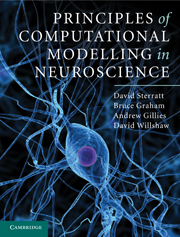Crossref Citations
This Book has been
cited by the following publications. This list is generated based on data provided by Crossref.
2011.
Building Brains.
p.
299.
Eglen, Stephen J.
2012.
Computational Systems Neurobiology.
p.
365.
Yamashita, Yutaro
and
Torikai, Hiroyuki
2012.
Bursting analysis and synapse mechanism of a piece-wise constant spiking neuron model.
p.
1.
Sterratt, David C.
and
Sporns, Olaf
2013.
On the Importance of Countergradients for the Development of Retinotopy: Insights from a Generalised Gierer Model.
PLoS ONE,
Vol. 8,
Issue. 6,
p.
e67096.
Lindley, Craig A.
2013.
Computing Nature.
Vol. 7,
Issue. ,
p.
71.
Ocone, Andrea
and
Sanguinetti, Guido
2013.
A stochastic hybrid model of a biological filter.
Electronic Proceedings in Theoretical Computer Science,
Vol. 124,
Issue. ,
p.
100.
Reeke, George
2013.
Neuroscience in the 21st Century.
p.
2333.
Kolaric, Katarina V.
Thomson, Gemma
Edgar, Julia M.
and
Brown, Angus M.
2013.
Focal axonal swellings and associated ultrastructural changes attenuate conduction velocity in central nervous system axons: a computer modeling study.
Physiological Reports,
Vol. 1,
Issue. 3,
Z. Pesenson, Misha (Meyer)
2013.
Multiscale Analysis and Nonlinear Dynamics.
p.
245.
Karabacak, Ozkan
Elibol, Rahmi
and
Sengor, Neslihan Serap
2014.
The role of synchronization of neural structures on neuron dynamics.
p.
1154.
Linaro, Daniele
and
Giugliano, Michele
2014.
Encyclopedia of Computational Neuroscience.
p.
1.
Vasilaki, Eleni
Giugliano, Michele
and
Lytton, William W.
2014.
Emergence of Connectivity Motifs in Networks of Model Neurons with Short- and Long-Term Plastic Synapses.
PLoS ONE,
Vol. 9,
Issue. 1,
p.
e84626.
Brown, Angus M.
and
Hamann, Martine
2014.
Computational modeling of the effects of auditory nerve dysmyelination.
Frontiers in Neuroanatomy,
Vol. 8,
Issue. ,
Rothman, Jason S.
2014.
Encyclopedia of Computational Neuroscience.
p.
1.
Timofeeva, Yulia
and
Coombes, Stephen
2014.
The Computing Dendrite.
Vol. 11,
Issue. ,
p.
449.
Graham, Bruce
2014.
Encyclopedia of Computational Neuroscience.
p.
1.
Mohapatra, Namrata
Deans, Horace T.
Santamaria, Fidel
and
Jedlicka, Peter
2014.
Encyclopedia of Computational Neuroscience.
p.
1.
2014.
The Physics of Living Processes.
p.
503.
2014.
The Physics of Living Processes.
p.
555.
Patoary, Mohammand Nazrul Ishlam
Tropper, Carl
Zhongwei Lin
McDougal, Robert
and
Lytton, William W.
2014.
Neuron Time Warp.
p.
3447.





